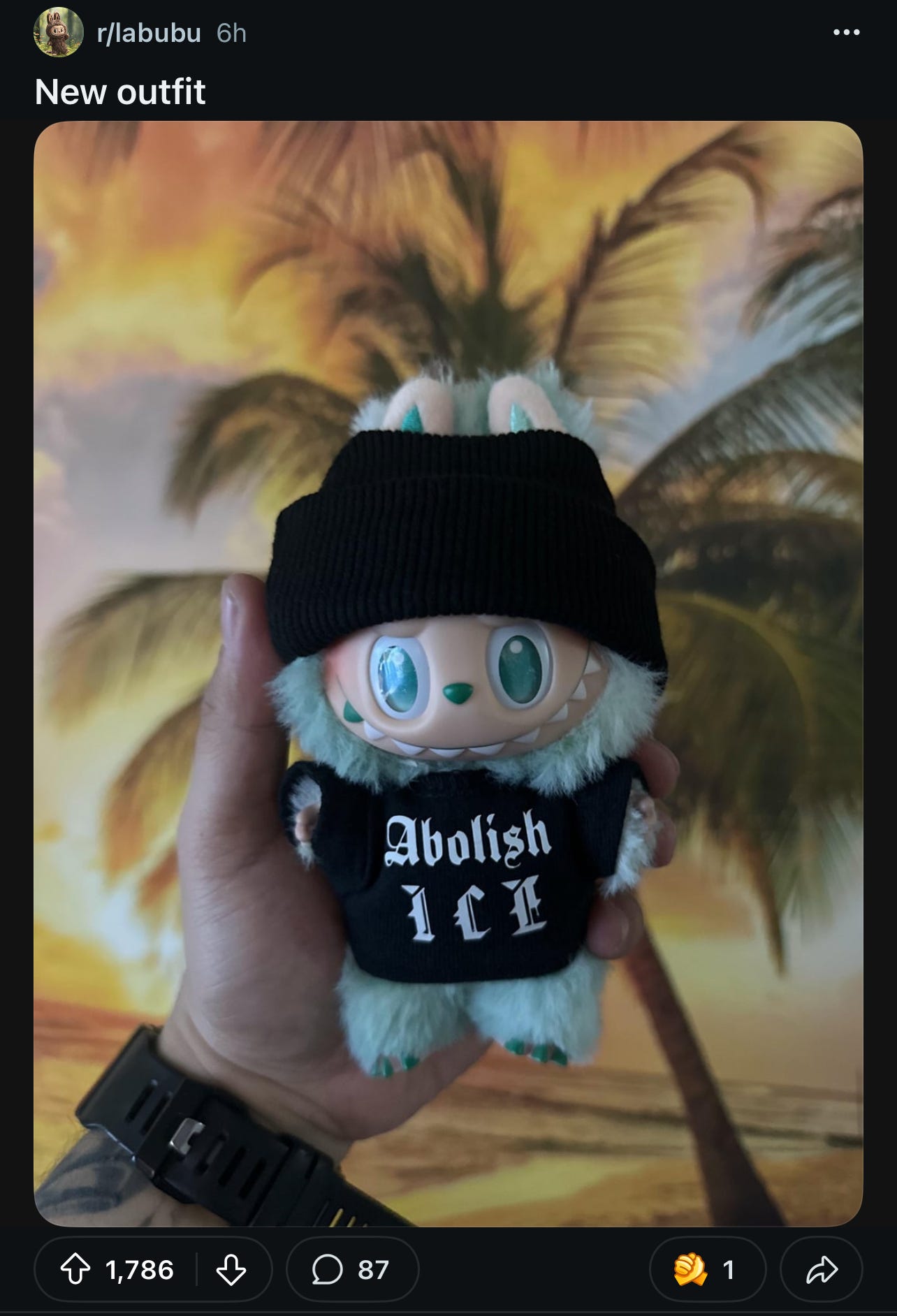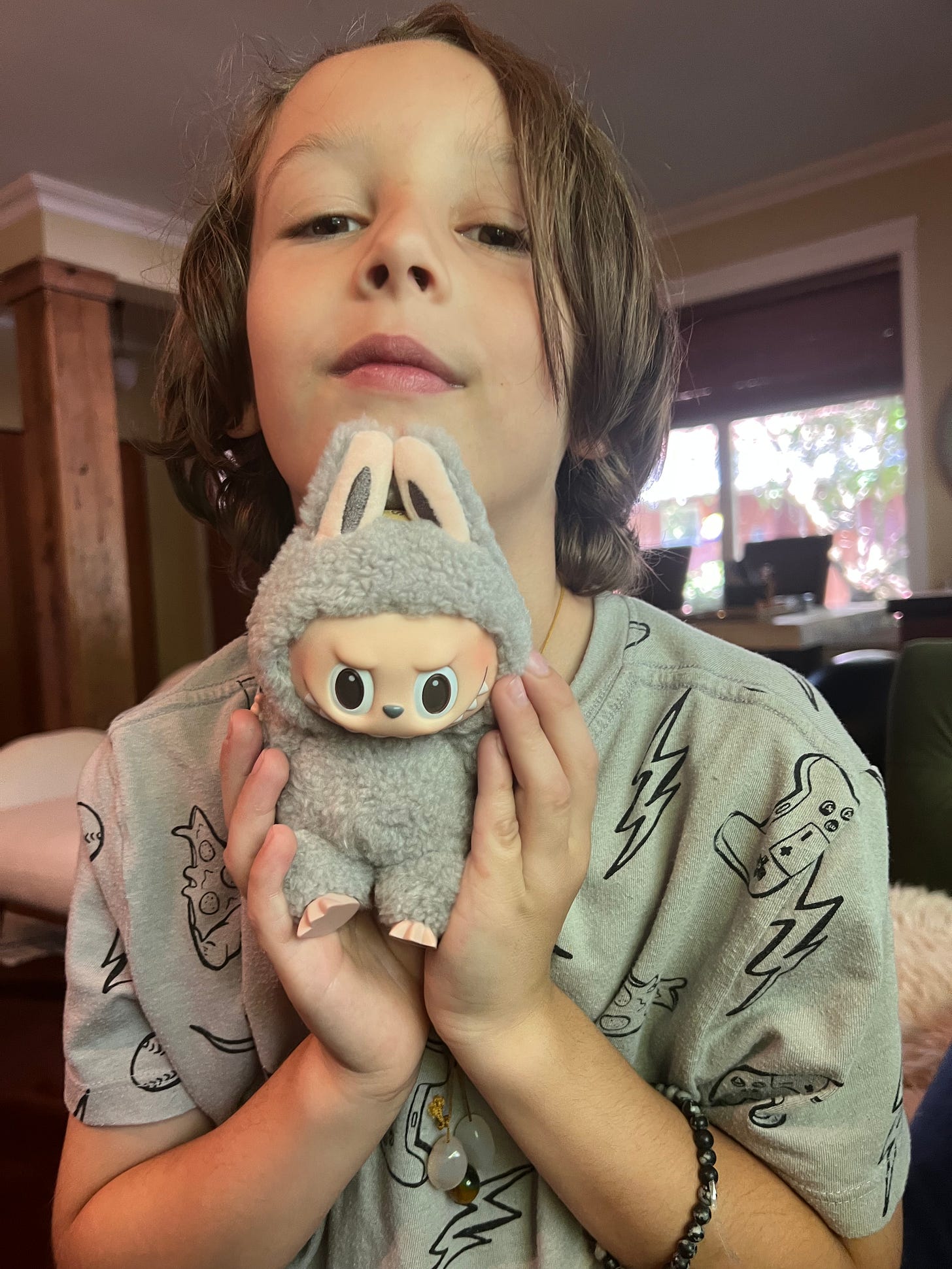What the hell is a Labubu and why do I want one so badly?
One week later, I was meeting a stranger from a craigslist ad in a back alley, hoping to purchase three Exciting Macaron Labubus
“Labubu” entered my lexicon only a few weeks ago, though the character—a toy monster elf based on Nordic mythology—has been around for a decade.
It started with my sons began asking if they could get a Labubu. Shortly after this, my social media became inundated with reels of influencers unboxing the cute little things for their jealous audiences. I say “jealous” because one of the first things I learned about Labubu is that it’s exclusive—it’s nearly impossible to purchase one. Or six, for that matter: influencers often unbox an entire set of six at once, hoping that one in the set will be a rare, “secret” Labubu, which is a Labubu in a colour that appears randomly in 1/72 toys.
The toys are produced by Chinese company Pop Mart, and started to go viral last year, when K-pop star Lisa (BLACKPINK) attached one to her purse. Since then, celebrities including Rihanna, Dua Lipa, Kim Kardashian, David Beckham, and Marc Jacobs have all done the same.
At first, I was skeptical. I never fall for these trends; not for Beanie Babies, Furbys, or Tamagotchi. I figured I was immune to this sort of hype. One week later, however, I was meeting a stranger from a craigslist ad in a back alley, hoping to purchase three Exciting Macaron Labubus—one each for my sons and myself.
What the hell happened to me?
Academia and psychology offer several explanations for an obsession with viral toys.
SCARCITY, IMPULSIVITY, AND BOYS V. GIRLS
In his book, “Influence,” Robert Cialdini argued that scarcity—whether it’s a real or fabricated scarcity—drives demand for items or experiences. This certainly was the case for my sons, whose desire to own a Labubu intensified after we discovered that the entire collection sells out within minutes on Pop Mart’s website. They watched me browse for the monster dolls on my phone with a gravity well beyond the matter at hand.
“I want a Labubu so bad,” my six-year-old whispered to me as he fell asleep that night.
Interestingly, a 2022 Russian study, published in Frontiers in Psychology, found that “boys are 1.66 times more likely to prefer (a) trendy toy than girls.” The study also suggested that viral toys don’t support “full developmental potential,” because children want them not for any creative ways to play with them—but simply for the fact that they are viral. “I want it because I want it.”
Another finding in this study: that viral toys are “more often chosen by children who have difficulties in controlling impulsive cognitive reactions.” It tracks, then, that boys are more into viral toys than girls, because boys (and males, generally) are considered to have lower impulse control—with specific exceptions—than their female counterparts, in many animal and human studies.
CULTURAL CAPITAL
Obtaining a viral toy is a way to obtain “cultural capital,” a concept defined by sociologist Pierre Bourdieu. There are three types: embodied (such as a behaviour); objectified (like a cute little Labubu); and institutionalized (a type of formal recognition).
The concept of cultural capital is essentially academic-speak for having snobby and elitist taste in activities, belongings, and one’s associations.
You want a Labubu? Have you considered that you’re simply an elitist snob? I have. And you know what? I can live with that.
INFLUENCERS
We cannot talk about viral toys without talking about influencers. If you search “Labubu unboxing,” you will find hundreds of videos, with millions of views, of people ripping open packages of Labubus and screaming in excitement at each unveiling. It’s ridiculous, frankly—but my god, it sure works.
The field of research surrounding influencers is small but growing.
This year, a group of market psychology researchers listed areas of concern, and future study, regarding the social media stars who have increasing powers to shape our collective thoughts and desires: “Harmful Products, Misinformation, Unrealistic Beauty Standards, Comparison Culture, Deceptive Consumption, and Privacy Concerns.”
Out of the six areas of concern, I think “comparison culture” is the only one relevant to Labubus. We see what others have, and we want to have the same—or more.
Since I met that stranger in an alleyway to purchase three Labubus (at twice the Pop Mart retail price, for your information), I have already considered if I want to have more. My sons, bless their sweet hearts, are still ecstatic with theirs, and haven’t mentioned obtaining any other versions.
The woman I bought them from texted me this morning: “Hey Amy, I have a new, never used Coca Cola Labubu but it’s the sit down one and box has been opened by me. Just never used. (My own collection.) I’ve decided to let it go at $80. Let me know if you would like to consider before I list it.”
I passed on it. How far into this Labubu subculture am I willing to go?
On Reddit’s r/PopMartCollectors and r/labubu, you can find wild tales about couriers allegedly stealing Labubu boxes from packages, then sealing them up and delivering empty boxes to consumers. One mother posted that an adult stole a Labubu doll right from her daughter’s lap, while she was pushing her stroller through a grocery store. People are dressing their Labubus in tiny designer clothing, Gucci and Prada, and one even shared their custom “Abolish ICE” outfit for theirs.
At the park, my sons have faced huge fanfare from children at the sight of their Labubus (which they’ve been hanging off the neck of their shirts when they go to play). “OH MY GOD IT’S A LABUBU! Where did you get that?!” is the common reaction, followed by children asking me to share with their parents how I managed to buy some. One girl said nothing and immediately snatched my son’s gray Labubu right off his shirt, and he quickly snatched it back. There were no hard feelings involved—my son, it seems, immediately understood the girl’s impulsive reaction. He’s got that sweet, sweet cultural capital that all the kids want. It’s easier to play it cool from his position of elevated social standing—afforded by the possession of a 7-inch-tall monster elf with buck teeth.
“I’m the only kid in my class that has a Labubu,” he told me.
Like Marc Jacobs and Rihanna, I’ve taken to hanging my Labubu off the side of my purse.
Call it shallow, vain, silly, or anything else. You know what it also is? It’s fun. And it’s cute. And it makes us all feel good. I get a kick out of my kids’ reaction to seeing my Toffee Labubu swinging off my purse. I’m “cool” to them. I know I won’t always be perceived that way—and I’m going to enjoy it while it lasts.
I also recognize that there is a dwindling number of years—months, maybe, for my oldest—during which I will see my sons place an adorable soft toy on their pillows before going to sleep. How wholesome is that?
Thank you for reading! If you’re able, I am appreciative of your paid subscriptions. Either way, my content will remain free.
xo
Amy







Sweet, crazy, right.
When they want Lambos the fun begins.
Don't know about Labulus but Influence,” by Robert Cialdin is great book!